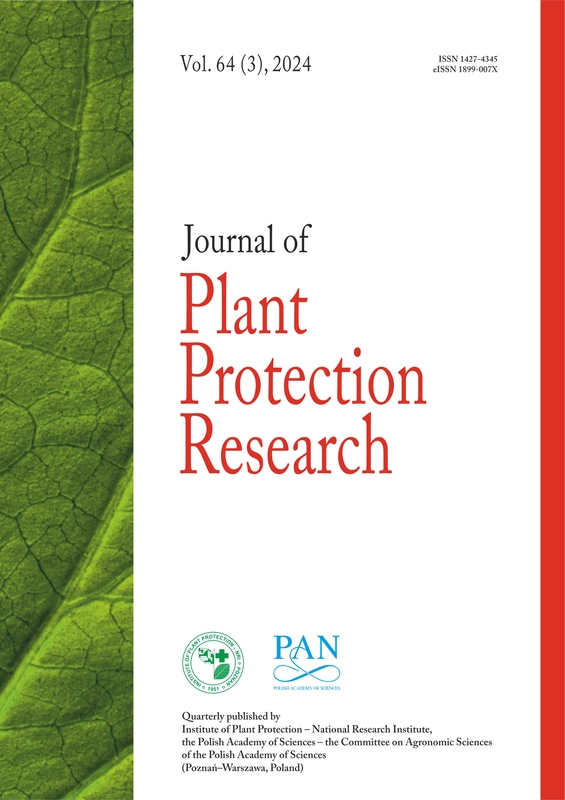ORIGINAL ARTICLE
The chemical grain composition of wheat and barley affects the development of the lesser grain borer (Rhyzopertha dominica F.) and the rice weevil (Sitophilus oryzae L.)
1
Faculty of Agriculture and Forestry, University of Warmia and Mazury in Olsztyn, Olsztyn, Poland
A - Research concept and design; B - Collection and/or assembly of data; C - Data analysis and interpretation; D - Writing the article; E - Critical revision of the article; F - Final approval of article
Submission date: 2024-02-16
Acceptance date: 2024-04-16
Online publication date: 2024-07-02
Corresponding author
Olga Kosewska
Faculty of Agriculture and Forestry, University of Warmia and Mazury in Olsztyn, Olsztyn, Poland
Faculty of Agriculture and Forestry, University of Warmia and Mazury in Olsztyn, Olsztyn, Poland
Journal of Plant Protection Research 2024;64(3):275-287
HIGHLIGHTS
- Different natural resistance to feeding by R. dominica and S. oryzae characterizes grain of different cereal species and cultivars
- S. oryzae develops better on wheat grain, and R. dominica on barley grain
- The antioxidants contained in the grain constitute a natural barrier against pests
- Cereal cultivars high in protein and fat are attractive to R. dominica and S. oryzae
KEYWORDS
TOPICS
ABSTRACT
The lesser grain borer (Rhyzopertha dominica F.) and the rice weevil (Sitophilus oryzae L.)
are stored grain pests that cause significant economic losses in grain storage. This study
aimed to analyze the impact of the chemical composition of wheat and barley grain (e.g.,
protein, fatty acids and total antioxidant capacity) on the development of two species of
storage pests and to determine the relationship between the analyzed variables. The study
involved the evaluation of 10 wheat cultivars and 10 barley cultivars under laboratory conditions.
The observations included assessing the beetles’ progeny abundance, dust mass
produced after feeding, and grain mass loss. The chemical composition of the tested wheat
and barley cultivars was also determined, and the influence of different chemical compositions
on insect development was investigated. The results of the experiment revealed diversity
of resistance among cultivars to pest feeding. Larger populations of the lesser grain
borer were observed on barley grains, while rice weevil populations were higher on wheat.
Cultivars with higher protein and fat content were more susceptible to pest attacks. A connection
between the amount of dust, grain mass loss, and the type of pest was also identified,
indicating differences in feeding mechanisms and selective food preferences of these
insects. The grain chemistry of wheat cultivars, including the content of fatty acids and
antioxidants, significantly influenced the progeny abundance of S. oryzae, suggesting the
potential of these components as natural barriers against storage pests. This study provides
valuable insights for developing breeding strategies to enhance the natural resistance of
new grain cultivars to these pests, contributing to the reduction of pesticide use. Statistical
analyses confirmed the significance of differences in grain composition in varied resistance
to the studied pests. The conclusions drawn from this work may help establish new storage
and breeding practices, promoting sustainable agriculture and protecting natural resources.
FUNDING
The results presented in this paper were obtained from
a comprehensive study financed by the University of
Warmia and Mazury in Olsztyn, Faculty of Agriculture
and Forestry, Department of Entomology, Phytopathology
and Molecular Diagnostics. This work was
supported by the University of Warmia and Mazury
research project in Olsztyn (no. 30.610.010-110 and
30.610.011-110). The study was supported by the Polish
National Science Centre under project no. UMO-
2021/41/N/NZ9/00364.
RESPONSIBLE EDITOR
Magdalena Karbowska-Dzięgielewska
CONFLICT OF INTEREST
The authors have declared that no conflict of interests exist.
Share
RELATED ARTICLE
We process personal data collected when visiting the website. The function of obtaining information about users and their behavior is carried out by voluntarily entered information in forms and saving cookies in end devices. Data, including cookies, are used to provide services, improve the user experience and to analyze the traffic in accordance with the Privacy policy. Data are also collected and processed by Google Analytics tool (more).
You can change cookies settings in your browser. Restricted use of cookies in the browser configuration may affect some functionalities of the website.
You can change cookies settings in your browser. Restricted use of cookies in the browser configuration may affect some functionalities of the website.




